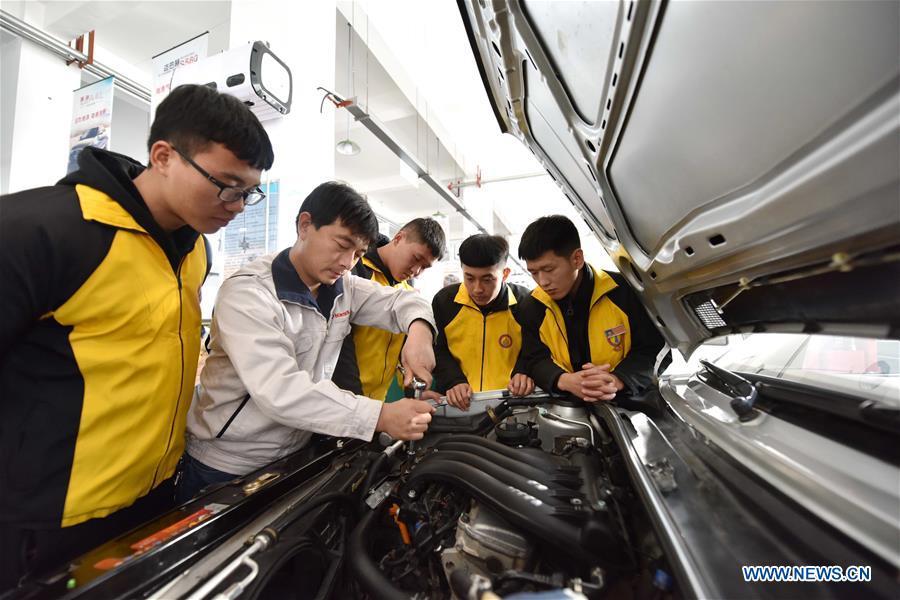Educationlevel
Vocationalschooleducationisdividedintoelementary,secondary,andhighervocationalschooleducation.Elementaryandsecondaryvocationalschooleducationareimplementedbyelementaryandsecondaryvocationalschoolsrespectively.Secondaryvocationaleducationisthevocationaleducationcarriedoutatthestageofhighschooleducation,includingsomepost-highschoolvocationaltraining.Itiscurrentlythemainbodyofvocationaleducationinmycountry.Itspositioningistotrainalargenumberofskilledpersonnelandhigh-qualityworkersonthebasisofcompulsoryeducation.
SettingStandards
NotificationLetter
NoticeoftheMinistryofEducationonPrintingandDistributingthe"SecondaryVocationalSchoolSettingStandards"
TeachingandVocationalSuccess[2010]No.12DepartmentofEducation(EducationCommission)ofallprovinces,autonomousregionsandmunicipalitiesdirectlyundertheCentralGovernment:
SinceourMinistryissuedthe"StandardsforSettingupSecondaryVocationalSchools(Trial)"in2001,China'ssecondaryvocationaleducationhasmadegreatprogress.Thedevelopmentenvironmentofvocationaleducationhasalsoundergonegreatchanges.Inordertofurtherpromotetheconstructionofsecondaryvocationalschoolsandstrengthenthemanagementofsecondaryvocationalschoolsunderthenewsituation,ourMinistryhasrevisedthe"StandardsforSettingupSecondaryVocationalSchools(Trial)".Therevised"StandardsforSettingupSecondaryVocationalSchools"arenowprintedanddistributedtoyou,pleasefollowthemandimplementthem.Alllocalitiesshallinspectandevaluatesecondaryvocationalschoolsinaccordancewiththe"StandardsfortheEstablishmentofSecondaryVocationalSchools".Forsecondaryvocationalschoolsthatdonotmeetthestandards,theymustmeetthestandardswithinatimelimitandeffectivelychangethescatteredandThesmallandpoorsituationpromotestheconstructionofsecondaryvocationalschoolstoscaleandlevel.
MinistryofEducationofthePeople’sRepublicofChina
July6,2010
Plaintextofdocuments
Article1Inordertostandardizetheestablishmentofsecondaryvocationalschools,promoteschoolconstruction,ensurethequalityofeducation,andimprovetheefficiencyofrunningschools,thisstandardisformulatedinaccordancewiththe"EducationLaw"andthe"VocationalEducationLaw".
Article2Thisstandardappliestoalltypesofsecondaryvocationalschoolsestablishedbycitizens,legalpersonsandotherorganizationsinaccordancewiththelaw.
Article3TheestablishmentofasecondaryvocationalschoolshallconformtothelocalvocationaleducationdevelopmentplanandmeetthebasicconditionsstipulatedintheVocationalEducationLaw.
Article4Secondaryvocationalschoolsshallhavethequalificationsforlegalpersonsandshallregisteraslegalpersonsinaccordancewiththerelevantregulationsofthestate.
Article5Theestablishmentofasecondaryvocationalschoolshallhaveaschoolcharter.Theschoolcharterincludes:name,schoolsite,schoolpurpose,schoolinternalmanagementsystemandoperatingmechanism,facultymanagement,studentmanagement,educationandteachingmanagement,schoolpropertyandfinancialmanagement,revisionoftheschoolcharter,etc.
Article6Secondaryvocationalschoolsshouldhaveabasicschoolscale.Amongthem,thenumberofstudentsinschooleducationshouldbemorethan1,200.
Article7Secondaryvocationalschoolsshouldhaveateamoffull-timeteacherssuitablefortheschool'sschoolscale,withanappropriateproportionofpart-timeteachers.Therearegenerallynolessthan60full-timeteachers,withateacher-studentratioof1:20,andfull-timeteachers’academicqualificationsshouldmeetrelevantnationalregulations.Amongthefull-timeteachers,thenumberofseniorprofessionalandtechnicalpositionsisnotlessthan20%.Thenumberofprofessionalteachersshouldnotbelessthan50%ofthenumberoffull-timeteachersintheschool,andthenumberofdouble-qualifiedteachersshouldnotbelessthan30%.Eachmajorshouldbeequippedwithatleast2full-timeteacherswithintermediateoraboveprofessionalandtechnicalpositionsintherelevantmajor.Hiringpart-timeteacherswithpracticalexperienceshouldaccountforabout20%ofthetotalnumberoffull-timeteachersintheschool.

Article8Thereshouldbecampuses,schoolbuildingsandfacilitiessuitableforthescaleofschoolandtheprofessionalsetting.Campusarea(excludingfacultyandstaffdormitoriesandrelativelyindependentaffiliatedinstitutions):Thetotallandareaplannedfortheconstructionofthenewschoolisnotlessthan40,000squaremeters;thelandareaperstudentisnotlessthan33squaremeters.Schoolbuildingarea(excludingfacultyandstaffdormitoriesandrelativelyindependentaffiliates):Theplannedareaofthenewschoolbuildingisnotlessthan24,000squaremeters;theschoolbuildingareaperstudentisnotlessthan20squaremeters.Sportsland:Thereshouldbeatrackandfieldfieldwithacirculartrackofmorethan200meters,andotherfacilitiesandvenuesthatmeettheneedsofteachingandsportsactivities,andmeetthebasicrequirementsofthe"SchoolSportsWorkRegulations".Healthcareandcampussafetyinstitutionsaresound,teachingandlivingfacilitiesandequipmentmeetthebasicrequirementsofthe"SchoolHygieneWorkRegulations",andcampussafetyisguaranteed.Libraryandreadingroom:Applicableprintedbooksarenolessthan30forstudents;therearemorethan80typesofnewspapersandperiodicals;thenumberofseatsintheteacher'sreading(data)roomandthestudent'sreadingroomshouldbenolessthan20%ofthetotalnumberoffull-timeteachersandstudents10%ofthetotalisset.Instrumentsandequipment:thereshouldbeexperimentalandpracticefacilitiesandequipmentthatmatchtheprofessionalsettingandmeettheteachingrequirements.Theperstudentvalueofinstrumentsandequipmentforengineeringmajorsandmedicalmajorsisnotlessthan3,000yuan,andtheaveragevalueofequipmentforothermajorsisnotlessthan2,500yuan.Internshipandtrainingbase:Theremustbeanon-campustrainingbaseandarelativelystableoff-campusinternshipbasesuitableforthemajorsetuptomeettheneedsofstudents'internshipandtraining.Musthavesoftwareandhardwarefacilitiesandequipmentthatcanapplymoderneducationaltechnologytoimplementmoderndistancevocationaleducationandschoolmanagementinformation.Amongthem,thenumberofschoolcomputersisnotlessthan15per100students.
Article9Secondaryvocationalschoolsimplementtheprincipalresponsibilitysystem.Secondaryvocationalschoolsshouldbeequippedwithschoolleaderswhohavehighideologicalandpoliticalqualities,strongmanagementcapabilities,andarefamiliarwiththelawsofvocationaleducationdevelopment.Theprincipalshouldhavemorethanthreeyearsofexperienceineducationandteaching,theprincipalandthevice-principalofteachingshouldhaveabachelordegreeoraboveandseniorprofessionaltechnicalpositions,andotherschool-levelleadersshouldhaveabachelordegreeoraboveandintermediateprofessionaltechnicalpositions.
Article10Theestablishmentofasecondaryvocationalschoolshouldhaveamajorthatmeetstheneedsoflocalsocialandeconomicconstruction,aclearteachingplan,syllabusandotherteachingdocuments,andcorrespondingCurriculumstandardsandteachingmaterials.
Article11Secondaryvocationalschoolsshouldhavenecessaryeducation,teachingandmanagementinstitutions.
Article12ThefundingforsecondaryvocationalschoolsshouldberaisedandimplementedthroughmultiplechannelsinaccordancewiththeVocationalEducationLawandrelevantlocalregulations.Normalfundssuchasschoolinfrastructure,experimentaltrainingequipment,teachertraining,andper-studentfundingshouldhavestableandreliablesourcesandpracticalguarantees.
Article13Thisstandardisthebasicstandardforsettingupsecondaryvocationalschools,andisthebasicbasisfortheapproval,inspection,evaluation,andsupervisionofsecondaryvocationalschoolsbytheeducationaladministrativedepartment.Forexample,inthefuture,relevantnationaldepartmentshavenewregulationsontheareaoflandusedbystudentsinsecondaryvocationalschoolsandthebuildingareaofschoolbuildingsperstudent,subjecttothenewregulations.Provincialeducationadministrativedepartmentsmayformulatemeasuresfortheestablishmentofsecondaryvocationalschoolshigherthanthisstandard.Fortheestablishmentofsecondaryvocationalschoolsinremoteandpoverty-strickenareas,theschoolscaleandcorrespondingschoolconditionscanbeappropriatelyrelaxed.ThespecificstandardsareformulatedbytheprovincialeducationadministrativedepartmentbasedonthisstandardandreportedtotheMinistryofEducationfortherecord.Forsports,art,specialeducationandothertypesofsecondaryvocationalschools,thebasicrequirementsforthescaleofrunningschoolsandthecorrespondingconditionsforrunningschoolswillbeseparatelyannouncedbytheMinistryofEducationinconjunctionwithrelevantdepartments.
Article14Thisstandardshallcomeintoforceonthedateofissuance.The"StandardsforSettingupSecondaryVocationalSchools(Trial)"formulatedbytheMinistryofEducationin2001wereabolishedatthesametime.
Schoolclassification
Whilesecondaryvocationalschoolsprovidestudentswithhighschoollevelculturalknowledgeeducation,theyalsoimplementtargetedvocationalknowledgeandvocationalskillseducationaccordingtotherequirementsofvocationalpositions.Dividedintotwocategories:publicandprivate.
Therearefourtypesofsecondaryvocationalschools:vocationalhighschools,generaltechnicalschools,adulttechnicalschoolsandtechnicalschools.Technicalschoolshavegraduallydevelopedintothreetypesoftechnicalschools,advancedtechnicalschools,andtechnicalcolleges.Amongthem,technicalschools(techniciancolleges)aremanagedbythehumanresourcesandsocialdepartments,andvocationalhighschools,generaltechnicalsecondaryschoolsandadulttechnicalsecondaryschoolsaremanagedbytheeducationdepartment.
ProfessionalSettings
SeetheProfessionalEducationCatalog(2021).
Employmentrate
2015
AccordingtothewebsiteoftheMinistryofEducation,in2015,thenumberofgraduatesfromsecondaryvocationalschoolsnationwidewas5,154,700,andthenumberofemployedpersonswas4,964,200,Theemploymentrateis96.30%,andthecounterpartemploymentrateis77.60%.Fromtheperspectiveofemploymentdestinations,thedata(notincludingtechnicalschoolsbelow)showthattheemploymentofstateagencies,enterprisesandinstitutionsaccountedfor52.04%ofthetotalemployment,whichisstillthemaindestinationofsecondaryvocationalgraduates;thelegallyengagedinself-employmentaccountedfor16.27%,11.67%areemployedinotherways,indicatingthatmoregraduatesareengagedinentrepreneurialemploymentandplayapositiveroleinpromoting"massentrepreneurshipandinnovation".20.02%ofthoseenrolledinvarioushigher-levelschoolsaccountedforanincreaseof4.7percentagepointsfrom2014.
Fromtheperspectiveofemploymentstructure,thoseemployedintheprimaryindustryaccountedfor10.87%ofthedirectemployment;thoseemployedinthesecondaryindustryaccountedfor32.93%;thoseemployedinthetertiaryindustryaccountedfor56.20%,andtheproportionisstillmorethanhalf.Intermsofmajorcategories,thenumberofgraduates,numberofemployedpersons,andemploymentrateofprocessingandmanufacturingmajorsrankfirst.Theemploymentsituationisthebest,withanemploymentrateof97.30%;followedbyinformationtechnology,reaching96.85%;transportation,transportation,etc.Theemploymentrateofeducation,leisureandhealthcare,financeandcommerceisabove96.23%onaverage.Thisshowsthatsecondaryvocationaleducationkeepspacewiththedevelopmentofmodernserviceindustriesandadvancedmanufacturingindustries,andatthesametimesupportsthedevelopmentofnewindustriessuchastransportation,e-commerce,andmodernlogistics,andhasabettersupportingroleinpromotingthedevelopmentoftherealeconomy.Intermsofgeographicdistributionofemployment,2,291,900peoplewereemployedlocally,accountingfor70.75%ofthedirectemployment;936,700peoplewereemployedindifferentplaces,accountingfor28.92%;10,700wereemployedoverseas,accountingfor0.33%.Comparedwith2014,thenumberofregionswithanemploymentratehigherthanthenationalaveragehasincreasedby5to27,andtheemploymentgapamongregionshasshownanoverallnarrowingtrend.Thisshowsthattheemploymentareaofsecondaryvocationalgraduatesisstilldominatedbylocalemployment,whichisthenewforceofregionaleconomicandsocialdevelopment.Atthesametime,morethan70%ofsecondaryvocationalgraduateswereregisteredinruralareaswhentheyenrolled,butmorethan90%ofstudentswereemployedinurbanareasaftergraduation.Thisshowsthatsecondaryvocationaleducationhashelpedruralyoungstudentsobtainemploymentskillsandstablejobs,promotedtheintegrationofstudentsintourbanlife,andeffectivelypromotedtheconstructionofnewurbanization.
Fromtheperspectiveofemploymentquality,amongthedirectlyemployedstudents,theproportionofsignedlaborcontractsreached89.26%,anincreaseofmorethan1.22%over2014,andtheemploymentstabilityofgraduateshasbeencontinuouslyimproved.Theaveragemonthlystartingsalaryof2001-3000yuanaccountedfor29.56%,andthosewithanaveragemonthlystartingsalaryofmorethan3000yuanaccountedfor12.02%.Nearly84%ofemployedgraduateshavesocialinsurance,andthesocialsecuritystatusofgraduateshascontinuedtoimprove.84.12%ofgraduatesexpressed"relativelysatisfied","satisfied"and"verysatisfied"withtheiremploymentsatisfaction,anincreaseof4percentagepointsfrom2014.Graduates'satisfactionwithemploymentpositionshascontinuedtoincrease.Fromtheperspectiveofcareerguidance,78.65%ofthetotalnumberofgraduatesobtainedqualificationcertificatesupongraduation.Amongthedirectlyemployedstudents,73.32%wereemployedthroughschoolrecommendation;6.84%wereemployedthroughintermediaries;19.84%wereemployedthroughotherchannels.Schoolrecommendationisstillthemainemploymentchannel.
2016
In2016,thenumberofgraduatesfromsecondaryvocationalschoolsnationwidewas4,747,100,thenumberofemployedpersonswas4,591,500,andtheemploymentratewas96.72%.Thecounterpartemploymentrateis75.60%.
Fromtheperspectiveofemployment,thedata(notincludingtechnicalschoolsbelow)showthat45.49%oftheemployedpersonsareemployedingovernmentagencies,enterprisesandinstitutions;13.85%arelegallyengagedinself-employment,indicatingthattheyareinthecountryUnderthegeneralsituationofencouraginginnovationandentrepreneurship,manygraduateshavechosenthepathofentrepreneurshipandemployment.25.10%ofthoseenteringvarioushigher-levelschoolsaccountedforanincreaseof5.08percentagepointsfrom2015.Thisfullyshowsthatthecontinuouswideningoftheoverpassconnectingsecondaryvocationalschoolsandvocationalschoolshasprovidedopportunitiesformoresecondaryvocationalgraduatestoreceivehigher-leveleducation.Intermsofemploymentstructure,thoseengagedintheprimaryindustryaccountedfor8.55%ofthedirectemployment;thoseengagedinthesecondaryindustryaccountedfor31.43%;thoseengagedinthetertiaryindustryaccountedfor60.02%,anincreaseof4%overthepreviousyear,indicatingthattheserviceindustryhasbecomeasecondaryoccupationThemainchannelofemploymentforgraduates.Intermsofmajorcategories,thereare9majorcategoriesofcounterpartemploymentinenergyandnewenergy,processingandmanufacturing,education,medicineandhealth,tourismservices,textilefood,transportation,petrochemicals,andleisureandhealthcare.Theratesareallhigherthantheaveragecounterpartemploymentrate.Amongthem,theenergyandnewenergyprofessionalcounterpartemploymentrateisashighas81.60%.Thisshowsthatmoreandmoregraduateshaveachievedcounterpartemployment,andtheconstructionofsecondaryvocationalprofessionsismoreandmoreinlinewiththeneedsofeconomicandsocialdevelopment.
Fromthegeographicaldistributionofemployment,1,854,800peopleareemployedlocally,accountingfor67.26%ofthedirectemployment;9,400areemployedoverseas,accountingfor0.34%;893,700areemployedindifferentplaces,accountingfor32.40%.Anincreaseof3.49percentagepointsoverthepreviousyear.Theemploymentsituationofsecondaryvocationalgraduatesinvariousregionsisgenerallyimproving,andtheregionalgaphasbeennarrowing.Thisshowsthattheemploymentareaofsecondaryvocationalgraduatesisstilldominatedbylocalemployment,whichhasbecomethemainsourceoflocalindustryforcesandanimportanttalentsupportforeconomicandsocialdevelopment.
Fromtheperspectiveofemploymentquality,amongthedirectlyemployedstudents,88.68%ofthemhavesignedlaborcontracts,andtheemploymentstabilityisrelativelyhigh.Theaveragemonthlystartingsalaryof2001-3000yuanforemploymentaccountedfor37.70%,andthoseabove3,000yuanaccountedfor15.76%,anincreaseof3.74%over2015.Employmentgraduateswithsocialinsuranceaccountedfor84.61%.Graduates’salaryandsocialsecurityThesituationhasbeengreatlyimproved.Graduateswhoexpresseddissatisfactionwithemploymentsatisfactionaccountedforonly3.38%ofthetotalnumberofgraduates.
Fromtheperspectiveofcareerguidance,76.92%ofthetotalnumberofgraduatesobtainedqualificationcertificatesupongraduation.Amongthedirectlyemployedstudents,70.67%wererecommendedbytheschool;6.47%wereintroducedbyanintermediary;22.86%wereemployedbyotherchannels.Schoolrecommendationisstillthemainchannelofemploymentforsecondaryvocationalgraduates.
Developmentprospects
Inthe21stcentury,thetraininggoalsofthesethreetypesofsecondaryvocationalschoolsaregraduallyconverging,andtheschool-runningformsaregettingcloser.Thecountryclaimsthatithasdecidedtograduallybreaktheboundariesofdepartmentsthroughreforms,structuraladjustments,resourceintegration,etc.,andpushthemtowardintegration.
Tuition-freesubsidyfunds
Tuition-freesubsidyfundsforsecondaryvocationalschoolsincludenotonlysecondaryvocationalschools,butalsovocationalhighschools,technicalschools,secondaryschoolsaffiliatedtocollegesanduniversitiesandpublicofficesPrivategeneraltechnicalsecondaryschool(hereisathree-yearsecondaryvocationalschoolchangedtoathree-yearvocationalschoolsince2008.Thetrainingobjectives,textbooks,andteachingcontentofthepreviousfour-yeartechnicalsecondaryschoolaredifferent),adultsecondaryvocationalschools(includingemployees)Technicalsecondaryschool)etc.
EstablishingNationalScholarships
OnMay28,2019,theMinistryofEducationstatedthatstartingfromthefallsemesterof2019,thestatewillestablishnationalscholarshipsinsecondaryvocationalschools.
